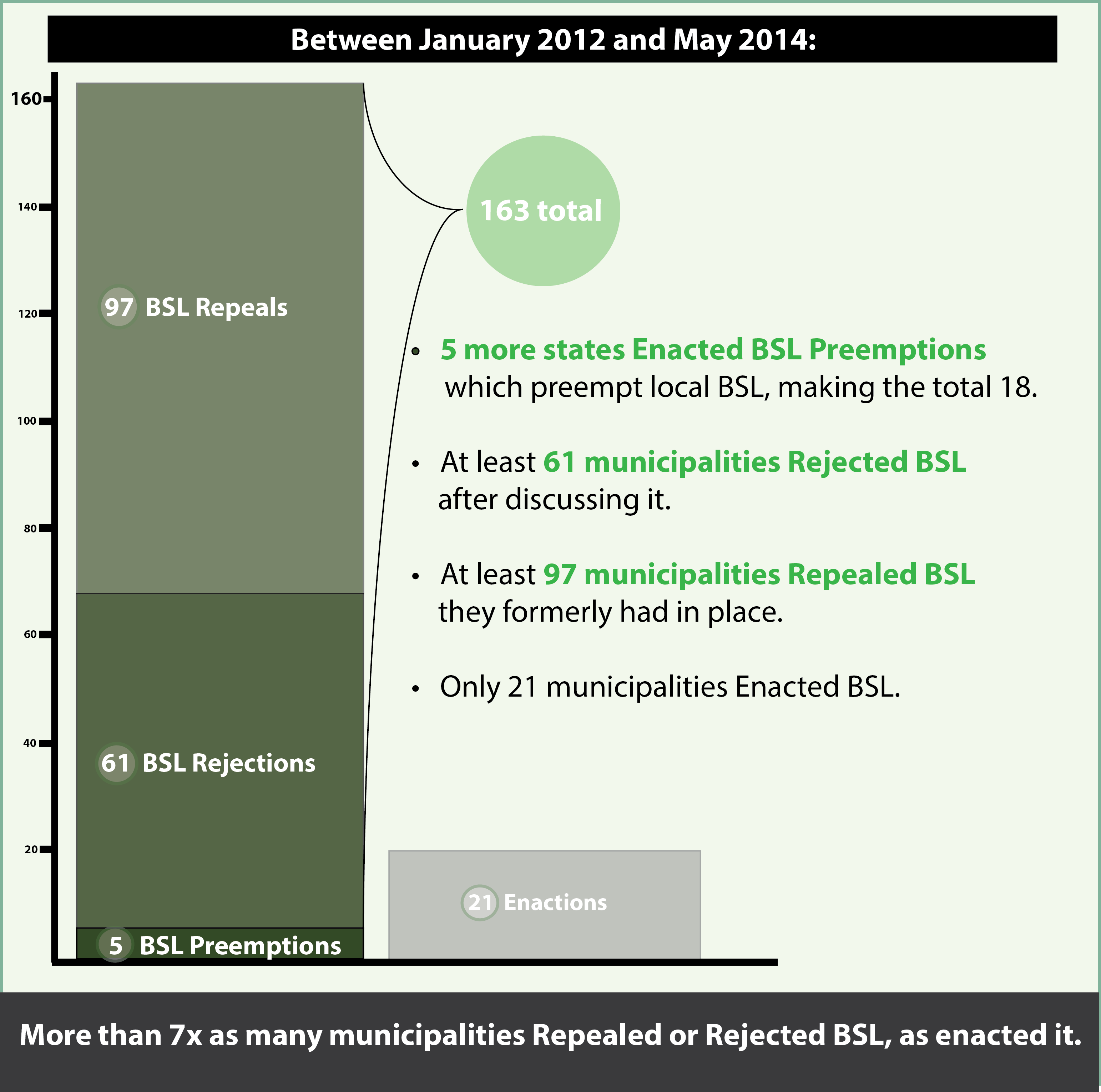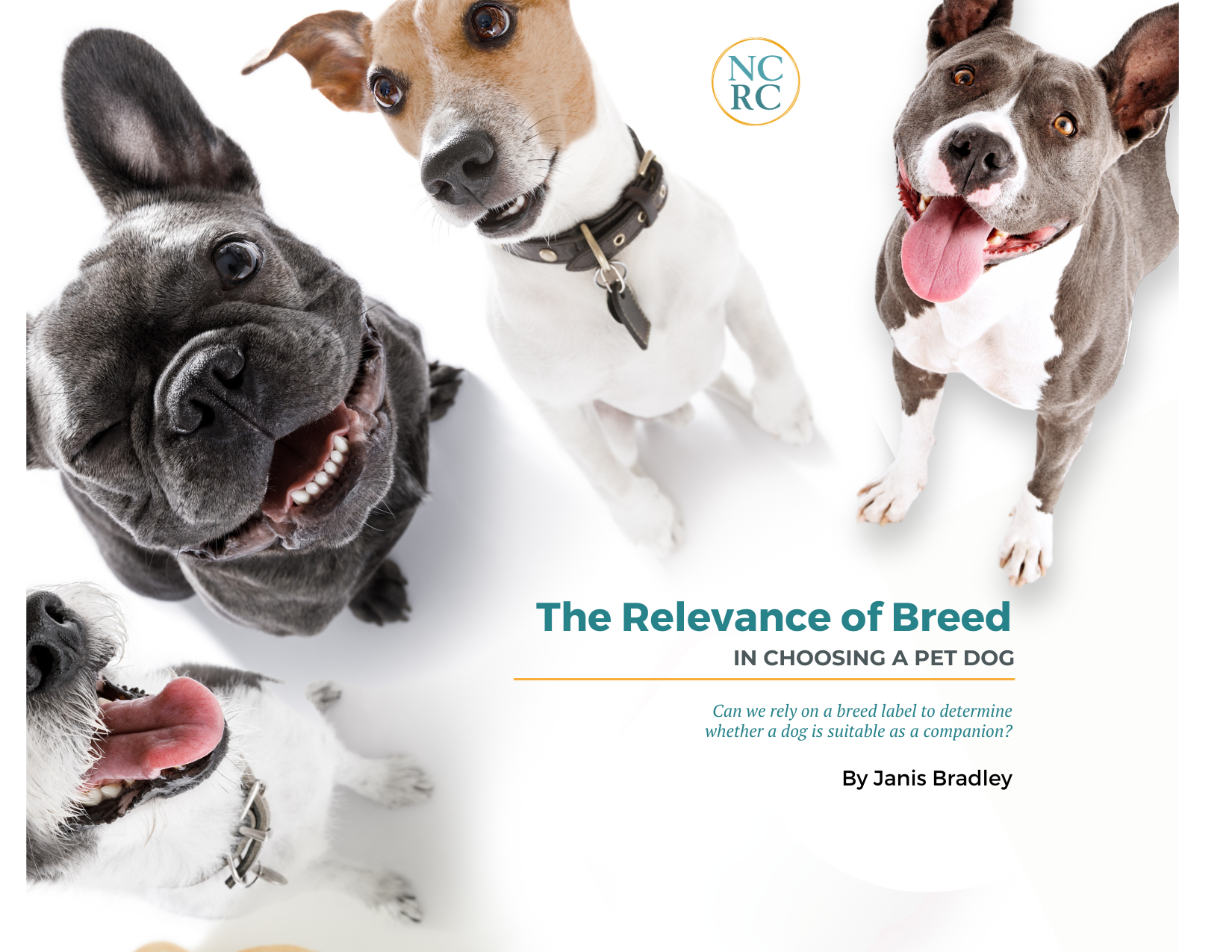Breed-Specific Legislation on the Decline :5 more states no longer allow BSL & more than 7x as many U.S. Municipalities repealed or rejected proposed BSL, than enacted it between: January 2012 – May 2014. |
The national trend is moving steadily away from breed-specific legislation (BSL) and toward breed neutral laws that hold all owners equally accountable for the humane care, custody and control of their dogs. The list of states that are considering and passing legislation to preempt municipalities from passing BSL continues to grow. BSL is a discriminatory law or ordinance that prohibits or restricts the keeping of dogs of specific breeds, dogs presumed to be specific breeds, mixes of specific breeds, and/or dogs presumed to be mixes of specific breeds. [1]  The trend reflects a growing understanding that regulating dogs on the basis of breed or physical description does not reduce dog bites.[2].[3],[4]. An analysis published in 2010 offers one explanation for the failure of BSL. [5] Most importantly, studies continue to show that one kind of dog is no more likely to threaten or bite a human being than another.[6],[7].[8]. The American Bar Association has urged the repeal of all BSL. [9] The White House also opposes BSL and released a statement saying, “research shows that bans on certain types of dogs are largely ineffective and often a waste of public resources.” [10] No major national organizations endorse BSL, including the American Veterinary Medical Association, the Centers for Disease Control, the Humane Society of the United States, the National Animal Control Association, the American Society for the Prevention of Cruelty to Animals, and Best Friends Animal Society. The tide has turned against BSL and communities are implementing policies that hold all dog owners responsible for the humane care, custody, and control of their dogs, regardless of breed or appearance. Building safer and more humane communities requires multifactorial approaches focusing on improved ownership and husbandry practices, better understanding of dog behavior, education of parents and children regarding safety around dogs, and consistent enforcement of dangerous dog/reckless owner ordinances in communities.[11],[12]. Updated June 16, 2014
The trend reflects a growing understanding that regulating dogs on the basis of breed or physical description does not reduce dog bites.[2].[3],[4]. An analysis published in 2010 offers one explanation for the failure of BSL. [5] Most importantly, studies continue to show that one kind of dog is no more likely to threaten or bite a human being than another.[6],[7].[8]. The American Bar Association has urged the repeal of all BSL. [9] The White House also opposes BSL and released a statement saying, “research shows that bans on certain types of dogs are largely ineffective and often a waste of public resources.” [10] No major national organizations endorse BSL, including the American Veterinary Medical Association, the Centers for Disease Control, the Humane Society of the United States, the National Animal Control Association, the American Society for the Prevention of Cruelty to Animals, and Best Friends Animal Society. The tide has turned against BSL and communities are implementing policies that hold all dog owners responsible for the humane care, custody, and control of their dogs, regardless of breed or appearance. Building safer and more humane communities requires multifactorial approaches focusing on improved ownership and husbandry practices, better understanding of dog behavior, education of parents and children regarding safety around dogs, and consistent enforcement of dangerous dog/reckless owner ordinances in communities.[11],[12]. Updated June 16, 2014
Sources and Notes:
[1] The most drastic form of BSL is a complete ban, but BSL also includes any laws that impose separate requirements or limitations on dogs and dog owners, including but not limited to: mandatory spay/neuter, muzzling requirements, liability insurance requirements, special licensing and additional fees, mandatory microchipping or tattoos, owner / walker age requirements, property posting requirements, confinement and leash requirements, breed-specific pet limits, sale or transfer notification requirements, restrictions on access to certain public spaces with the dog [e.g.: public parks; school grounds], required town-issued items [e.g.: fluorescent collar; vest], training requirements, requirement that photos of the dog and/or owner be kept on town file. BSL, in any form, results in the destruction of many pet dogs. For more information and to stay up-to-date with BSL, please see the NCRC BSL Map: http://nationalcanineresearchcouncil.com/dog-legislation/bsl-map
[2] National Canine Research Council. (2013). Denver’s Breed-Specific Legislation: Brutal, Costly, and Ineffective. Retrieved from: http://nationalcanineresearchcouncil.com/uploaded_files/tinymce/Denver%20BSL%20Brutal,%20Costly,%20and%20Ineffective%20_%20Aug%202013.pdf
[3] Rosado, B., García-Belenguer, S., León, M., & Palacio, J. (2007). Spanish dangerous animals act: Effect on the epidemiology of dog bites. Journal of Veterinary Behavior, 2(5): 166-174.
[4] Cornelissen, J.,M., & Hopster, H. (2010). Dog bites in the Netherlands: a study of victims, injuries, circumstances and aggressors to support evaluation of breed specific legislation. Veterinary Journal, 186(3): 292-298.
[5] Patronek, G.J., Slater, M., & Marder, A. (2010). Use of a number-needed-to-ban calculation to illustrate limitations of breed-specific legislation in decreasing the risk of dog bite-related injury. Journal of the American Veterinary Medical Association, 237(7): 788-792.
[6] American Veterinary Medical Association: Animal Welfare Division. (2012). Dog Bite Risk and Prevention: The Role of Breed. Retrieved from: https://www.avma.org/KB/Resources/LiteratureReviews/Pages/The-Role-of-Breed-in-Dog-Bite-Risk-and-Prevention.aspx
[7] Guy, N. C., Luescher, U. A., Dohoo, S. E., Spangler, E., Miller, J. B., Dohoo, I. R., & Bate, L. A. (2001). Demographic and aggressive characteristics of dogs in a general veterinary caseload. Applied Animal Behaviour Science, 74(1), 15-28.
[8] Casey, R. A., Loftus, B., Bolster, C., Richards, G.J., & Blackwell, E.J. (2014). Human directed aggression in domestic dogs (Canis familiarias): Occurrence in different contexts and risk factors. Applied Animal Behavior Science, 152, 52-63.
[9] American Bar Association. (2012). Resolution 100: Adopted by the House of Delegates. Retrieved from: http://www.americanbar.org/content/dam/aba/administrative/mental_physical_disability/Resolution_100.authcheckdam.pdf
[10] The White House. (2013). Breed-Specific Legislation Is a Bad Idea. Retrieved from: https://petitions.whitehouse.gov/response/breed-specific-legislation-bad-idea
[11] National Canine Research Council. (2013). Causes and Prevention. Retrieved from: http://nationalcanineresearchcouncil.com/dogbites/causes-and-prevention/
[12] Patronek, G.J., Sacks, J.J., Delise, K.M., Cleary, D.V., & Marder, A.R. (2013). Co-occurrence of potentially preventable factors in 256 dog bite-related fatalities in the United States (2000-2009). Journal of the American Veterinary Medical Association, 243(12), 1726-1736.







